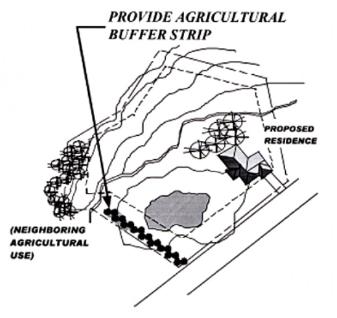- Learn about the County's Agricultural Resources here.
- Agricultural Frequently Asked Questions are available here.
- Agricultural Buffer Setbacks County Code section: SCCC 16.50.095
- Farmworker Housing Code Section: SCCC 13.10.631
- Learn about the Williamson Act Program here.
The purpose of the agricultural buffer setback requirements is to prevent or minimize potential conflicts between either existing or future commercial agricultural and other land uses (e.g., residential, recreational, institutional, commercial, or industrial) that involve habitable structures or other areas of intensive human activity. This 200-foot buffer is designed to provide a physical barrier to noise, dust, odor, and other effects which may be a result of normal commercial agricultural operations such as: plowing, disking, harvesting, spraying or the application of agricultural chemicals, and animal rearing.
Proposals to construct within the 200-foot buffer will be considered by the Agricultural Policy Advisory Commission (APAC) at a public hearing. Examples of common uses that will require approval of an Agricultural Buffer Reduction from the Agricultural Policy Advisory Commission:
- Single Family Dwellings, Accessory Dwelling Units (ADUs), and habitable accessory structures
- Outdoor spaces associated with intensive human use such as patios, decks, and swimming pools
- Outdoor areas associated with commercial, industrial, recreational, or institutional uses such as public parking, dining patios, and other areas designed for intensive human use.
- Agricultural uses involving intensive human activity (such as facilities for public assembly)
- Sleeping quarters or workplace facilities where employees are stationed.
- Some smaller projects, including ADU’s or less than 1,000 square foot additions to structures already developed within the established agricultural buffer setback, can be processed administratively without the requirement for public hearing or can be exempted from the agricultural buffer requirements altogether.
In most cases, agricultural buffer reductions can be approved if mitigations to potential or negative impacts to adjacent or surrounding commercial agricultural land are present or proposed on-site. Existing mitigations can include changes in topography, permanent substantial vegetation, or other physical barriers. Proposed mitigations include the establishment of a physical barrier (typically a 6-foot-tall solid wood fence with a vegetative buffer) and the recordation of a Statement of Acknowledgement on the property title which acknowledges the potential for conflicts between the agricultural and non-agricultural uses.
The Agricultural Policy Advisory Commission has approved the following list of recommend plant species for use as vegetative buffers:
Recommended Agricultural Buffer Plant List1
Approved by the Agricultural Policy Advisory Commission

| Common Name |
Botanical Name |
| Manzanita |
Arctostaphylos sp. |
| Coyote Brush2 |
Baccharis pilularis |
| California lilac3 |
Ceanothus sp. |
| California buckwheat |
Eriogonum fasciculatum |
| Flannelbush |
Fremontodendron californica |
| Coast silktassel |
Garrya elliptica |
| Toyon4 |
Heteromeles arbutifolia |
| Deergrass |
Muhlenbergia rigens |
| Catalina cherry5 |
Prunus lyonii |
| Holly-leaf cherry |
Prunus ilicifolia |
| Coast Live Oak |
Quercus agrifolia |
| Coffeeberry |
Rhamnus californica |
| Sugar bush |
Rhus ovata |
Notes:
- Refer to UC Extension and California Food and Agriculture websites for current information regarding host plants that may be associated with agricultural pests.
- Not for planting adjacent to rangeland.
- Not for planting adjacent to vineyards.
- Not for planting adjacent to apple or pear orchards.
- Attractive to birds because of their fruit.